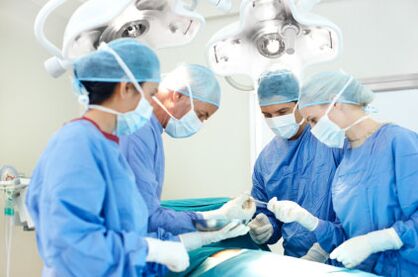In contrast to animals, humans move on two legs with a straight back. The main focus is shifted so that the greatest load is on the lumbar spine. Other factors that increase exposure include obesity, heavy lifting, and flat feet. At the same time, the fibrous ring of the intervertebral discs becomes thinner over time, leading to the formation of protuberances and hernias. The vertebrae themselves take on an irregular shape due to the formation of outgrowths (osteophytes). It is this process that sooner or later leads to the development of lumbar osteochondrosis.
Symptoms and methods of diagnosis
In order to understand how to cure osteochondrosis of the lumbar spine, it is necessary to find out all the causes of its occurrence and the degree of damage to the surrounding tissues. Diagnosis of the disease is based on examination, collection of anamnesis data on the clinical picture (manifestations and symptoms) and instrumental methods.
The clinical picture of lumbar osteochondrosis consists of the following symptoms:
- the appearance of pain in the lumbar region, leg and buttocks on the side of the lesion;
- sensory disturbance (anesthesia, paresthesia);
- decreased motor activity of the lower extremities;
- Involvement in the process of dysfunction of the pelvic organs (urinary incontinence, impotence).
Symptoms usually gradually increase as the pathological changes progress. Based on these manifestations, the doctor can only suspect lumbar osteochondrosis. A definitive diagnosis can only be made after examining and conducting several studies.
Upon examination, a competent specialist will definitely check for the presence of a number of characteristic reflexes:
- Postural reflex, in which the doctor lifts the patient's straight leg and the pain increases. After bending the limb in the knee joint, the pain immediately disappears.
- Bechterew's reflex is the appearance of pain when pressing the extended knees on a flat surface.
Instrumental methods make it possible to obtain additional information about the state of the spinal cord and nerve tissue of the roots in the immediate vicinity of the spinal lesion. X-rays and magnetic resonance imaging are usually done, sometimes computed tomography.
Having determined that the disease is present, it is necessary to decide how to treat lumbar osteochondrosis. There are a variety of ways to do this, ranging from taking pills to surgery. In some cases, reflexology and massage help.
Medical treatment
Drug treatment of lumbar osteochondrosis is aimed at eliminating its manifestations. To relieve the severity of pain and reduce inflammation, use:
- Non-steroidal anti-inflammatory drugs. By reducing inflammatory manifestations and blocking pain receptors, taking these drugs decreases the pain associated with nerve root irritation. These drugs can be used in various dosage forms (injections, tablets, ointments and gels).
- Glucocorticosteroid hormones are used when painkillers are ineffective. Their action is stronger, reducing the swelling of nerve tissue, and therefore they reduce the irritating effect of bone growths on the roots. However, due to possible systemic effects and side effects, their long-term use is not recommended.
To protect the cartilage tissue from further destruction, drugs for the treatment of lumbar osteochondrosis necessarily contain chondroprotectors. And although their effectiveness has not yet been proven, this group of drugs is widely used to treat this condition.
In order to reduce the manifestations of mental disorders (depression, neurosis), which often accompany this disease, sedatives are prescribed for lumbar osteochondrosis. They help the patient cope with pain. Antidepressants are used if there is a pronounced depression in mood.
In addition, it is necessary to use vitamin preparations for lumbar osteochondrosis, as they help reduce the negative impact on the spinal cord and its roots. Groups B and C drugs are usually prescribed because they are the most protective of nerve tissue.
Physiotherapeutic procedures
Treatment of osteochondrosis of the lumbar spine should be supplemented with effective physiotherapeutic procedures outside of periods of exacerbation. Most often, various effects are applied to the reflexogenic points responsible for the blood supply and nutrition of the affected area. These areas can be influenced by:
- magnetotherapy;
- Acupuncture;
- electroacupuncture;
- cauterization with cold or heat;
- Application or administration of drugs (pharmacopuncture).
With pharmacopuncture, by injecting the solution directly into the changed area, it is possible to significantly reduce the concentration of the drug, thereby eliminating most of the undesirable side effects. The use of these additional methods can increase the effectiveness of drug treatment of lumbar osteochondrosis.
Manual therapy

Manual therapy or massage necessarily include the treatment of lumbar osteochondrosis in the complex.
The doctor can set himself a number of tasks, which differ depending on the patient:
- loosen tense back muscles by stroking and vibrating;
- improving blood circulation in the lumbar region;
- strengthens the muscle frame with deep kneading;
- Return the displaced vertebra to its place.
An individual approach allows you to develop an optimal strategy and determine how to treat lumbar osteochondrosis with maximum efficiency.
physical therapy
Sometimes it happens that in the near future the patient cannot see a doctor and starts asking friends how to treat lumbar osteochondrosis. The safest in this case is to use a gymnastics complex designed specifically to strengthen the lower back.
It should be remembered that during periods of exacerbation you can not do any load other than breathing exercises and relaxation. In the future, you can add other exercises to strengthen the press and back muscles (push-ups, leg swings, etc. ). At the same time, it is important not to make sudden movements of large amplitude, since fragile vertebrae can easily move. In this regard, it is very desirable to start classes with a doctor-instructor, and then continue on your own at home.
ethnoscience
Folk remedies for lumbar osteochondrosis should be used in addition to the main treatment, but not instead of it. Since any intervention can harm the patient, it is necessary to first coordinate all your measures and the use of alternative methods with your doctor.
Various products made from plant-based raw materials are usually used for this purpose:
- To prepare a locally irritating ointment that improves blood supply to the affected area, you will need five red peppers and 100 ml of kerosene and vegetable oil. After receiving the infusion, it is necessary to lubricate the sore spots at night. A dry wool compress is placed over this.
- Butter and hop cones are mixed in equal parts. The resulting ointment is applied to the lumbar region as needed.
- An infusion of arnica, walnuts and a healing letter should be taken a spoonful after each meal.
Treatment of lumbar osteochondrosis with folk remedies can be effective in the early stages of the process. Therefore, it is necessary to start therapy immediately after the onset of symptoms.
Surgical intervention

Surgical treatment of lumbosacral osteochondrosis is carried out quite rarely and only if there are no significant effects of other methods within six months. Other indications for surgery include cauda equina syndrome penetrating the spinal canal in this area and acute nerve root compression.
The most common type of surgery is to remove a damaged disc (discectomy). During the operation, the doctor removes the offending parts of the vertebrae and intervertebral discs and, if possible, fixes the spine in the correct position.
This operation in this case is considered the most productive method, but it is prescribed only if other methods of treatment do not bring results within six months. In addition, the method of microsurgical and endoscopic treatment of the spine is widespread.
Since intervention in the structure of the spine can lead to very serious consequences (paresis, complete paralysis), treatment of lumbar osteochondrosis should be carried out only in a designated neurosurgical clinic.
How to treat an exacerbation of lumbar osteochondrosis?
Treatment for exacerbation of osteochondrosis of the lumbar spine, usually drugs. However, to eliminate severe symptoms, medical intervention is required. To eliminate acute pain, you can perform the so-called blockade. To do this, use an anesthetic, which is injected directly into the affected area with a special needle.
Muscle relaxants are used to relax the spasmodic back muscles during an exacerbation of the disease. These drugs block neuromuscular conduction and help relax muscles and clear "jams. "
If the patient is in severe pain, an anesthetic must be injected into a vein or muscle. Sometimes this is enough to alleviate the condition.
disease prevention
In order not to wonder how to cure lumbar osteochondrosis, the best option is to prevent this disease. Basic rules to help with this include:
- do not stay in a forced position for more than half an hour, try to warm up and, if possible, change your position;
- Do not lift heavy objects and coordinate all loads with the trainer when training in the gym.
- do not lie on a cot or in a hammock, it is better to sleep and rest on a hard bed to avoid deflection and displacement of the vertebrae;
- wear comfortable shoes with a small heel (less than 4 cm);
- avoid increasing your own weight;
- Replace the bag with a backpack so the load is evenly distributed.
- Swim in the pool or ponds to give your lower back a break.
If you follow these simple recommendations, you may never think about how to get rid of lumbar osteochondrosis. If this disease still develops, it is necessary to consult a doctor in a timely manner. With the help of a complex therapeutic effect, in most cases it is possible to get rid of the symptoms of this pathology and continue to lead a normal life.




















